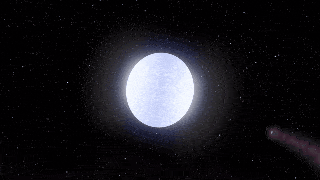Imagine a planet like Jupiter zipping around its host star every day and a half, superheated to temperatures hotter than most stars and sporting a giant, glowing gas tail like a comet.
That’s what astronomers think they found orbiting a massive star called KELT-9, located 650 light years from Earth in the constellation Cygnus.

With a day-side temperature peaking at 4,600 Kelvin (more than 7,800 degrees Fahrenheit), the newly discovered exoplanet, designated KELT-9b, is hotter than most stars and only 1,200 Kelvin (about 2,000 degrees Fahrenheit) cooler than our own sun. In fact, the ultraviolet radiation from the star it orbits is so brutal that the planet may be literally evaporating away under the intense glare, producing a glowing gas tail.
The super-heated planet has other unusual features, too. For instance, it’s a gas giant 2.8 times more massive than Jupiter but only half as dense, because the extreme radiation from its host star has caused its atmosphere to puff up like a balloon.
Because it is tidally locked to its star—as the moon is to Earth—the day side of the planet is perpetually bombarded by stellar radiation and, as a result, it is so hot that molecules such as water, carbon dioxide, and methane can’t form there.
“It’s a planet by any of the typical definitions based on mass, but its atmosphere is almost certainly unlike any other planet we’ve ever seen just because of the temperature of its day side,” says Scott Gaudi, professor of astronomy at Ohio State University and one of the lead authors of the study in Nature.
Why so hot?
The reason the exoplanet is so hot is because the star it orbits is more than twice as large and nearly twice as hot as our sun. “KELT-9 radiates so much ultraviolet radiation that it may completely evaporate the planet. Or, if gas giant planets like KELT-9b possess solid rocky cores as some theories suggest, the planet may be boiled down to a barren rock, like Mercury,” says Keivan Stassun, professor of physics and astronomy at Vanderbilt University.
On the other hand, the planet’s orbit is extremely close to the star so if the star begins to expand it will engulf it.
“KELT-9 will swell to become a red giant star in about a billion years,” Stassun says. “The long-term prospects for life, or real estate for that matter, on KELT-9b are not looking good.”
While Stassun and Gaudi spend a lot of time developing missions, such as the NASA’s Transiting Exoplanet Survey Satellite, designed to find habitable planets in other solar systems, they say there’s a good reason to study worlds that are unlivable in the extreme.
‘Puffy planet’ has the same density as styrofoam
“The astronomical community is clearly focused on finding Earthlike planets around small, cooler stars like our sun. They are easy targets and there’s a lot that can be learned about potentially habitable planets orbiting very low-mass stars in general. On the other hand, because KELT-9b’s host star is bigger and hotter than the sun, it complements those efforts and provides a kind of touchstone for understanding how planetary systems form around hot, massive stars,” Gaudi says.
“As we seek to develop a complete picture of the variety of other worlds out there, it’s important to know not only how planets form and evolve, but also when and under what conditions they are destroyed,” Stassun adds.
Planet-hunting
“We were pretty lucky to catch the planet while its orbit transits the face of the star,” says coauthor Karen Collins, a postdoctoral fellow at Vanderbilt. “Because of its extremely short period, near-polar orbit and the fact that its host star is oblate, rather than spherical, we calculate that orbital precession will carry the planet out of view in about 150 years, and it won’t reappear for roughly three and a half millennia.”
In 2014 astronomers spotted the exoplanet using one of two telescopes specially designed to detect planets orbiting bright stars—one in the northern and one in the southern hemisphere—jointly operated by Ohio State, Vanderbilt, and Lehigh universities.
The “Kilodegree Extremely Little Telescopes” or KELTs, fill a large gap in the available technologies for finding extrasolar planets. They use mostly off-the-shelf technology to provide a low-cost means of planet hunting. Whereas a traditional astronomical telescope costs millions of dollars to build, the hardware for a KELT telescope runs less than $75,000. Where other telescopes are designed to look at very faint stars in small sections of the sky at very high resolution, KELTs look at millions of very bright stars at once, over broad sections of sky, at relatively low resolution.
Has the seventh Trappist-1 planet always been so cold?
“This result demonstrates that even ‘extremely little’ telescopes can play an important role in discovery,” says James Neff, astronomical sciences program director at the National Science Foundation, which partially funded the research.
Using the KELT-North telescope at Winer Observatory in Arizona, the astronomers noticed a tiny drop in the star’s brightness—only about half of one percent—which indicated that a planet may have passed in front of it. The brightness dipped once every 1.5 days, which means the planet completes a “yearly” circuit around its star every 1.5 days. Subsequent observations confirmed that the signal was caused by a transiting planet and revealed that it was what astronomers call a “hot Jupiter”—an ideal kind of planet for the KELT telescopes to spot.
The astronomers hope to take a closer look at KELT-9b with other telescopes—including Spitzer, the Hubble Space Telescope (HST) and eventually the James Webb Space Telescope after it launches in 2018. Observations with HST would enable them to see if the planet really does have a cometary tail and allow them to estimate how much longer the planet will survive its current hellish condition.
American partner institutions include Ohio State University, Vanderbilt University, Fisk University, Pennsylvania State University, the Harvard-Smithsonian Center for Astrophysics, Las Cumbres Observatory Global Telescope Network, University of Notre Dame, Lehigh University, NASA Ames Research Center, Bay Area Environmental Research Institute, Swarthmore College, IPAC, Brigham Young University, University of California-Santa Cruz, University of Wyoming, Louisiana State University, University of Louisville, Spot Observatory in Nashville, Westminster College, Kutztown University, University of Hawaii, University of Washington, Texas A&M University, Wellesley College, and Winer Observatory in Sonoita, AZ. International team members are from Denmark, Italy, Japan, Portugal, Switzerland, Australia, Germany, and South Africa.
Additional funding came from NASA via the Jet Propulsion Laboratory and the Exoplanet Exploration Program; the Harvard Future Faculty Leaders Postdoctoral Fellowship; the Fund for Astronomical Research; and the Japan Society for the Promotion of Science.
Source: Vanderbilt University



